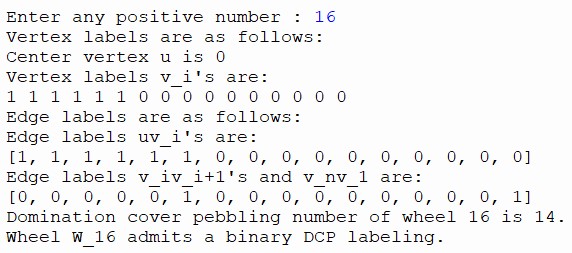A graph labeling is an assignment of integers to the vertices or edges or both, which satisfies certain conditions. The domination cover pebbling number of a graph
All graphs discussed here are simple, finite and connected. We
consider a graph
A pebbling move [3,4] is the removal of two pebbles from one vertex and the addition of one pebble to an adjacent vertex .
Gardner et al. [5]
presented the concept of domination cover pebbling number in to the
literature. The domination cover pebbling number of a graph
In this paper we introduce a new concept known as binary domination cover pebbling (DCP) labeling. Also, we investigate some graphs that satisfy binary DCP labeling and give a programming approach to binary DCP labeling.
Definition 1. Let
The readers can get the information about the graphs
In Table 1, we state the domination cover pebbling number of some families of graphs. We then determine all such graphs that admit a binary domination cover pebbling (DCP) labeling.
|
Domination Cover Pebbling Number |
Reference | |
|
Path |
|
[8] |
|
Odd Cycle |
|
[8] |
|
Even Cycle |
|
[8] |
|
Wheel graph |
|
[5] |
|
Star graph |
|
[7] |
|
Fan graph |
|
[7] |
|
Binary tree |
|
[5] |
|
Lollipop graph |
3 | [9] |
|
Square of path |
3 | [6] |
|
Square of path |
5 | [6] |
|
Square of path |
6 | [6] |
|
Square of path |
9 | [6] |
|
Square of path |
10 | [6] |
|
Pseudo star graph |
|
[7] |
|
Fuse graph |
|
[7] |
Lemma 1. Suppose
Proof. By definition, it is not possible to label all the
vertices and edges by 1. The upper bound is obtained. Consider the star
graph
Theorem 1. The path
Proof. Suppose
def vertex1(n):
if(i % 4 == 1):
return 1
else:
return 0
def vertex2(n):
if(i % 4 == 2):
return 0
else:
return 1
def edge(i):
if(abs(v[i-1]-v[i]) == 1):
return 1
else:
return 0
n = int(input("Enter any positive number : "))
p = n
q = n-1
print("The cardinality of the vertices: ", p)
print("The cardinality of the edges: ", q)
v = [ ]
v_1 = 0
v_0 = 0
e_1 = 0
e_0 = 0
print("Vertex labels are as follows: ")
for i in range(1, p+1):
if(n == 3):
v.append(vertex1(i))
print(vertex1(i), end=" ")
if (vertex1(i)==1):
v_1 += 1
else:
v_0 += 1
elif(n == 4):
v.append(vertex2(i))
print(vertex2(i), end=" ")
if (vertex2(i)==1):
v_1 += 1
else:
v_0 += 1
else:
print("Path graph does not admit a binary DCP labeling.")
break
if(len(v) > 1):
print("\nEdge labels are as follows: ")
for i in range(1,len(v)):
print(edge(i), end=" ")
if (edge(i)==1):
e_1 += 1
else:
e_0 += 1
print("\nDomination cover pebbling number of the path graph
is", v_1+e_1,".")
print("\nPath Graph admits a binary DCP labeling.")Output

Theorem 2. The cycle
Proof. Let
Theorem 3. The wheel graph
Proof. Let
import math
def vertex(p) :
if (1 <= i <= math.ceil((n-4)/2)):
return 1
elif (math.ceil(((n-4)/2)+1) <= i <= n):
return 0
n = int(input("Enter any positive number : "))
v = [ ]
b = [ ]
c = [ ]
u = 0
print("Vertex labels are as follows: ")
print("Center vertex u is", u)
print("Vertex labels v_i's are: ")
for i in range(1, n+1) :
if n > 4:
if (n % 2 == 0):
v.append(vertex(i))
print(vertex(i), end= " ")
else:
print(f"Wheel W_{n} does not admit a binary DCP labeling.")
break
else:
print(f"Wheel W_{n} does not admit a binary DCP labeling.")
break
if len(v) >= 3:
for i in range(1, len(v)):
c.append(abs(u - v[i-1]))
b.append(abs(v[i-1] - v[i]))
c.append(abs(u - v[-1]))
b.append(abs(v[0] - v[-1]))
print("\nEdge labels are as follows: ")
print("Edge labels uv_i's are: ")
print(c, end = " ")
print("\nEdge labels v_iv_i+1's and v_nv_1 are: ")
print(b, end = " ")
pebble = sum(v)+sum(b)+sum(c)
print(f"\nDomination cover pebbling number of wheel {n} is {pebble}.")
print("\nWheel W_{n} admits a binary DCP labeling.")Output

Theorem 4. The star graph
Proof. Suppose
Theorem 5. The fan graph
Proof. Let
Theorem 6. The complete binary tree
Proof. Suppose
Theorem 7. The lollipop graph
Proof. Let
Theorem 8. The square
Proof. Suppose
Suppose
Suppose
Suppose
Suppose
Theorem 9. The pseudo star graph
Proof. If
If
The vertices of a fuse graph
Theorem 10. The fuse graph
Proof. Case 1.
We define a binary labeling
Case 2.
Define a binary labeling
Case 3.
For
Let
Let
Let
Let
We have explored the relationship between two graph parameters namely binary labeling and domination cover pebbling. We have determined binary DCP labeling for paths, cycles, star, fan, wheel, binary tree graphs, pseudo star graph and fuse graph. It would be interesting to find other families of graphs admitting a binary DCP labeling.
Gallian, J. A., 2015. A dynamic survey of graph labeling. The Electronic Journal of Combinatorics, 18, p.DS6.
Chung, F. R. K., 1989. Pebbling in hypercubes. SIAM Journal on Discrete Mathematics, 2(4), pp.467-472.
Hulbert, G., 1999). A survey of graph pebbling. Congressus Numerantium, 139, pp.41-64.
Gardner, J., Godbole, A. P., Teguia, A. M., Vuong, A. Z., Watson, N. and Yerger, C. R., 2008). Domination cover pebbling: Graph families. Journal of Combinatorial Mathematics and Combinatorial Computing, 64, pp.255-271.
Lourdusamy, A. and Mathivanan, T., 2011. The domination cover pebbling number of the square of a path. Journal of Prime Research on Mathematics, 7, pp.1-8.
Kim, J. Y. and Kim, S. S., 2006. The domination cover pebbling number of some graphs. Journal of the Chungcheong Mathematical Society, 19(4), pp.403-408.
Lourdusamy, A. and Mathivanan, T., 2018. The domination cover pebbling number for some cyclic graphs and path graphs. Ars Combinatoria, 138, pp.51-61.
Lourdusamy, A. and Mathivanan, T., 2013. Domination cover pebbling number for odd cycle lollipop. Sciencia Acta Xaveriana, 4(1), pp.35-70.
1970-2025 CP (Manitoba, Canada) unless otherwise stated.